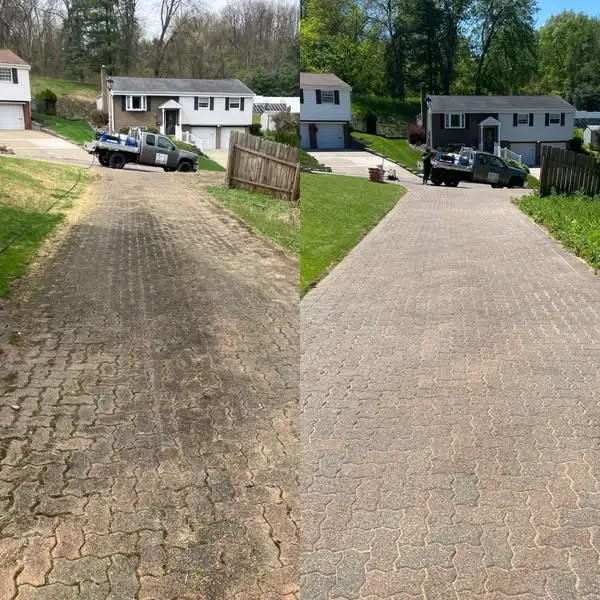Pressure washing is an essential maintenance task for concrete surfaces, ensuring they remain clean, safe, and visually appealing. At CC Pressure Washing, we understand that concrete surfaces, whether driveways, sidewalks, patios, or commercial spaces, face constant exposure to dirt, grime, mold, and other contaminants. This blog post delves into the factors influencing the frequency of pressure washing and offers guidelines to help you determine the best schedule for your concrete surfaces.
Why Pressure Washing Your Concrete is Important
Concrete surfaces are durable and long-lasting, but they are not impervious to the elements. Over time, dirt, mold, mildew, algae, and other pollutants can accumulate, leading to discoloration and surface degradation. Regular pressure washing helps to:
- Enhance Appearance: A clean concrete surface boosts the curb appeal of your property, making it look well-maintained and inviting.
- Increase Longevity: Removing harmful contaminants prevents damage and extends the life of your concrete surfaces.
- Improve Safety: Mold, algae, and oil spills can make concrete slippery and hazardous. Pressure washing reduces these risks.
- Prevent Damage: Regular cleaning prevents the buildup of materials that can cause cracks and other structural issues.
Factors Influencing How Often You Should Pressure Wash
The frequency of pressure washing depends on various factors, including:
- Location and Environment
- Urban Areas: Concrete surfaces in cities are exposed to pollutants, traffic grime, and other urban contaminants. These surfaces may require more frequent cleaning, approximately every 6 to 12 months.
- Suburban and Rural Areas: Less exposure to pollution means you might only need to pressure wash annually.
- Coastal Regions: Saltwater and sand can accelerate wear and tear. Quarterly pressure washing is often recommended.
- Usage
- High-Traffic Areas: Driveways, sidewalks, and commercial spaces with heavy foot or vehicle traffic accumulate dirt faster and might need pressure washing every few months.
- Low-Traffic Areas: Patios and areas with minimal traffic can often go longer, typically requiring annual cleaning.
- Climate and Weather Conditions
- Humid Climates: Regions with high humidity are prone to mold and mildew growth, necessitating more frequent pressure washing, potentially every 3 to 6 months.
- Dry Climates: In arid regions, dust and dirt are primary concerns, and a yearly pressure wash might suffice.
- Type of Contaminants
- Organic Growth: Areas with heavy vegetation or shaded regions are more susceptible to algae and moss, requiring more frequent cleaning.
- Pollution and Grime: Industrial areas or locations near busy roads may need more regular maintenance.
Recommended Pressure Washing Schedule
Considering the factors mentioned, here’s a general guideline for pressure washing different types of concrete surfaces:
- Residential Driveways: Every 6 to 12 months, depending on traffic and environmental conditions.
- Sidewalks and Walkways: Every 6 to 12 months, with higher frequency in high-traffic or shaded areas.
- Patios and Decks: Annually, unless there is significant mold or algae growth.
- Commercial Spaces: Quarterly to bi-annually, depending on foot traffic and exposure to pollutants.
Signs That Your Concrete Needs Pressure Washing
Even with a recommended schedule, it’s essential to be vigilant and look for signs that your concrete surfaces need pressure washing sooner than planned:
- Visible Stains and Discoloration: Oil stains, rust, or other marks indicate the need for cleaning.
- Mold and Mildew Growth: Green or black patches on the surface are a clear sign of mold and mildew.
- Slippery Surfaces: If your concrete becomes slippery when wet, it’s time to pressure wash.
- Dull and Dingy Appearance: Loss of the original color and a generally dingy look mean it’s time for a refresh.
DIY vs. Professional Pressure Washing
While DIY pressure washing can be effective for small areas or minor cleaning tasks, hiring professionals like CC Pressure Washing has distinct advantages:
- Expertise and Experience: Professionals understand the right pressure levels and cleaning agents for different surfaces, ensuring thorough cleaning without damage.
- Time and Effort: Professional services save you time and effort, delivering high-quality results quickly.
- Advanced Equipment: Professional-grade pressure washers are more powerful and efficient than consumer models.
- Safety: Professionals are trained to handle equipment safely and avoid potential hazards.
Tips for Maintaining Your Concrete Between Pressure Washings
To prolong the cleanliness and appearance of your concrete surfaces between pressure washings, consider the following tips:
- Regular Sweeping: Remove dirt and debris regularly to prevent buildup.
- Address Stains Promptly: Treat oil spills and stains immediately to prevent them from setting in.
- Use Mats and Rugs: Place mats at entryways and rugs on patios to minimize dirt and grime.
- Seal Your Concrete: Applying a sealant can protect your concrete from stains and weather damage.
Conclusion
Regular pressure washing is crucial for maintaining the beauty, safety, and longevity of your concrete surfaces. At CC Pressure Washing, we recommend evaluating your specific needs based on location, usage, climate, and the type of contaminants. Generally, residential driveways and sidewalks benefit from pressure washing every 6 to 12 months, while commercial spaces might require more frequent cleanings.
By staying vigilant and addressing the signs of dirt and contamination promptly, you can keep your concrete surfaces looking their best. Whether you choose to handle the task yourself or hire professionals, regular maintenance will ensure your property remains clean, safe, and appealing.
For professional pressure washing services, contact CC Pressure Washing. Our team of experts is equipped with the knowledge, experience, and equipment to deliver outstanding results, keeping your concrete surfaces in top condition all year round.


